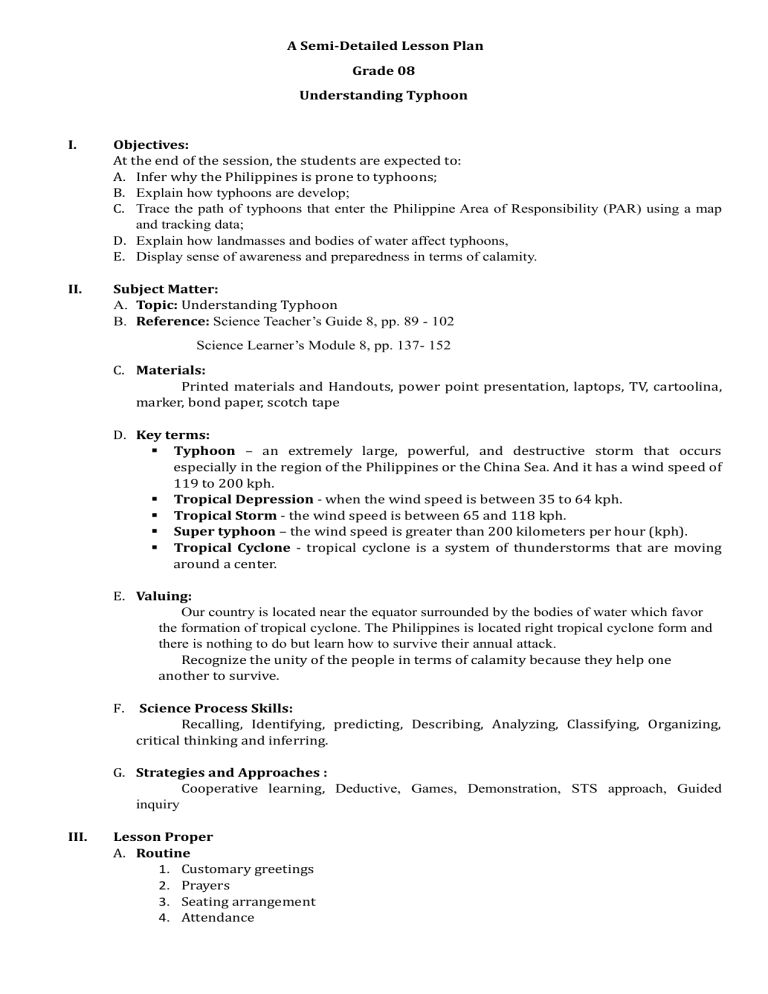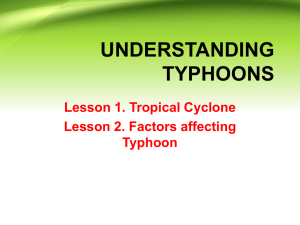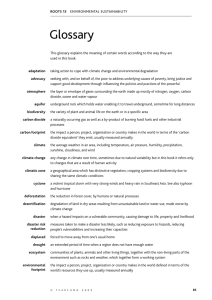
I.
A Semi-Detailed Lesson Plan
Grade 08
Understanding Typhoon
Objectives:
At the end of the session, the students are expected to:
A.
Infer why the Philippines is prone to typhoons;
B.
Explain how typhoons are develop;
C.
Trace the path of typhoons that enter the Philippine Area of Responsibility (PAR) using a map and tracking data;
D.
Explain how landmasses and bodies of water affect typhoons,
E.
Display sense of awareness and preparedness in terms of calamity.
II.
Subject Matter:
A.
Topic: Understanding Typhoon
B.
Reference:
Science Teacher’s Guide 8, pp. 89 - 102
Science Learner’s Module 8, pp. 137- 152
C.
Materials:
Printed materials and Handouts, power point presentation, laptops, TV, cartoolina, marker, bond paper, scotch tape
D.
Key terms:
Typhoon – an extremely large, powerful, and destructive storm that occurs especially in the region of the Philippines or the China Sea. And it has a wind speed of
119 to 200 kph.
Tropical Depression - when the wind speed is between 35 to 64 kph.
Tropical Storm - the wind speed is between 65 and 118 kph.
Super typhoon – the wind speed is greater than 200 kilometers per hour (kph).
Tropical Cyclone - tropical cyclone is a system of thunderstorms that are moving around a center.
E.
Valuing:
Our country is located near the equator surrounded by the bodies of water which favor the formation of tropical cyclone. The Philippines is located right tropical cyclone form and there is nothing to do but learn how to survive their annual attack.
Recognize the unity of the people in terms of calamity because they help one another to survive.
F.
Science Process Skills:
Recalling, Identifying, predicting, Describing, Analyzing, Classifying, Organizing, critical thinking and inferring.
G.
Strategies and Approaches :
Cooperative learning,
Deductive, Games, Demonstration, STS approach, Guided inquiry
III.
Lesson Proper
A.
Routine
1.
Customary greetings
2.
Prayers
3.
Seating arrangement
4.
Attendance
B.
Review a.) The teacher will group the students into 4 groups (Group 1, 2, 3, and 4). b.) The teacher will ask the student to bring something into the table c.) Who ever team that give that item first will have a chance answer the question . d.) Each item correspond an token. e.) The group who will have the highest point will be the winner.
C.
Motivation
The teacher will group the student and will conduct a
game which is entitled “You who leave a mark”. the teacher will give one question and every group will have 2 chances to give their answers.
Mechanics:
1.
Every group will give their answer one at a time.
2.
Answer must be given within 5 seconds. If not, the answer will not be accepted.
3.
Every answer corresponds to a certain point/s.
D.
Lesson Development
1.
The grouping from before will retain.
2.
The teacher will receive a letter from Kuya Kim.
3.
The teacher will call one student to read the letter.
Dear students
I’m Kuya Kim from “Weather Weather Lang station”. I’ve heard from PAGASA that they are monitoring a tropical cyclone in the Pacific Ocean. Can you please help me plot the Philippine area of responsibility on the map so that I can trace the path of the tropical cyclone? But, can you help me first in distinguishing the tropical cyclone categories?
The teacher will present the categories of tropical cyclone in the board.
E.
Activities
1.
The first activity is plotting the Philippine Area of responsibility. a.
The teacher will call the representatives in every group to get their materials. b.
The students will plot the given points on the map. c.
The students are given 5 minutes to finish the activity. d.
After finishing the activity, the students are required to answer the guide questions and write it in a manila paper and then present in the class.
2.
Tracking a tropical cyclone a.
The teacher will give the materials together with the activity sheet. b.
The students will track the pathway of the tropical cyclone and answer the guide question then present it in the class. c.
The students are given 5 minutes to finish the activity. The first group who will finish first will be given a price.
F.
Application:
The student will play a game wherein they will answer question
Mechanics:
1.
Each group will have a representative to in front and get a question
2.
They will be given 30 seconds to generalize their answer but if they cannot give the correct answer the other group we’ll have a chance to steal.
3.
But each group must have an animal sound call that will distinguish them, if they want to steal the question they must make the animal designated to them (chicken, dog, cat)
4.
You can answer even the timer is not finish
G.
Valuing:
The teacher will ask the students about the goodness in typhoon. Even though typhoon is very destructive, and we did not see any good side, there is one specific thing that we see goodness in typhoon. What is that?
H.
Generalization:
1.
The teacher will let the students create their on concept map about typhoon.
2.
They will be given 10 minutes to prepare.
3.
Each of the group will have one presenter.
4.
Each presenter will be given 2 minutes to present their concept map then afterward they will have to move to the other group to present their concept map.
5.
The job of the non-presenter is to take down note of the similarities and differences of each group’s concept map.
I.
Evaluation:
1.
The students will be given a signal of a typhoon.
2.
They will act what should be done in that given signal of typhoon.
3.
They are given 10 minutes to prepare.
H. Assignment
Compare the air pressure and wind speed at different places within a tropical cyclone.
Prepared by:
Science Department





